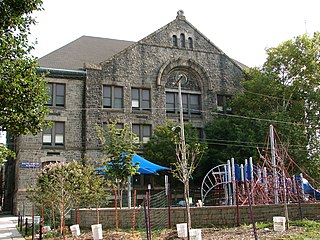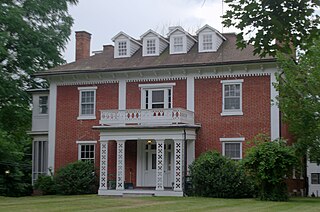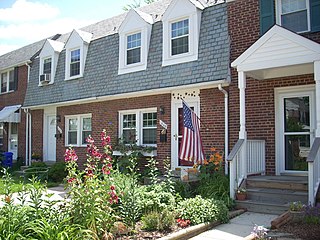The Ghent District is a historic neighborhood in Norfolk, Virginia. It comprises Ghent, West Ghent, and Ghent Square. Other portions of surrounding neighborhoods are often attributed to Ghent as an extension of its commerce including Chelsea, North Colley Avenue, and active gentrification into portions of Park Place to the north, labelled 'The Railroad District'.

Aberdeen Gardens is a national historic district located at Hampton, Virginia, United States. The district was part of a planned community initiated by Hampton University under New Deal legislation. The neighborhood is listed on the Virginia Landmarks Register and the National Register of Historic Places. The district encompasses 157 contributing buildings.
Wythe is a neighborhood in Hampton, Virginia, along the water's edge of Hampton Roads, at the end of Virginia's Lower Peninsula. It is named after one of the signers of the United States Declaration of Independence, George Wythe. The oldest historic portion of the Wythe neighborhood became known as Olde Wythe and is on the National Register of Historic Places.

Barton Heights is a streetcar suburb neighborhood and former town in the Northside area of Richmond, Virginia. The area was primarily developed between 1890 and the 1920s.

The Oak Park Historic District is a national historic district that is located in Hatfield Township, Montgomery County, Pennsylvania.

The Honesdale Residential Historic District, is a national historic district which is located in Honesdale, Wayne County, Pennsylvania.

The Bache-Martin Elementary School is a pre-kindergarten to eighth grade school which is located in the Fairmount neighborhood of Philadelphia, Pennsylvania. It is part of the School District of Philadelphia. The school campus comprises two distinct buildings along 22nd Street, both of which were listed on the National Register of Historic Places in 1986.

Frances E. Willard School is an elementary school located in the Port Richmond neighborhood of Philadelphia, Pennsylvania. It is part of the School District of Philadelphia. The school is named for suffragist Frances Willard.

Rosedale Historic District is a national historic district located at Covington, Alleghany County, Virginia. The district encompasses 76 contributing buildings, 1 contributing site, and 2 contributing structures in a predominantly residential section of Alleghany County. The buildings represent a variety of popular architectural styles including the Queen Anne, Greek Revival, and Classical Revival styles. The most notable residence is Rose Dale, constructed in the late-1850s as a plantation house. The Rosedale neighborhood was in established in 1899–1900. In addition to the dwellings a former hospital is situated in the district.

The Aurora Highlands Historic District is a national historic district located at Arlington County, Virginia. It contains 624 contributing buildings, 2 contributing sites, and 1 contributing structure in a residential neighborhood in South Arlington. Aurora Highlands was formed by the integration of three subdivisions platted between 1896 and 1930, with improvements in the form of modest single-family residences. The district is characterized by single family dwellings with a number of twin dwellings and duplexes, three churches, a rectory, two schools, two landscaped parks, and commercial buildings. The oldest dwelling is associated with “Sunnydale Farm” and is a Greek Revival-style dwelling built about 1870. The predominant architectural style represented is Colonial Revival.

The Virginia Heights Historic District is a national historic district located at Arlington County, Virginia. It is directly west of the Columbia Forest Historic District. It contains 117 contributing buildings in a residential neighborhood in southwestern Arlington. The area was developed between 1946 and 1952, and consists of four small subdivisions of Section Four of Columbia Forest, High Point, Virginia Heights, and Frederick Hill. The dwelling styles include Colonial Revival style houses and Modernist twin dwellings designed by noted local architect Charles M. Goodman. In addition, five single dwellings in Virginia Heights are known to be prefabricated houses, three of which are Lustron houses.

The Lyon Park Historic District is a national historic district and upper-class neighborhood located in Arlington County, Virginia. It contains 1,165 contributing buildings and 1 contributing site in a residential neighborhood in North Arlington. The area was platted between 1919 and 1951. The dwelling styles include a variety of architectural styles, ranging from Craftsman-style bungalows dating from the 1920s to Colonial Revival-style buildings dating from the 1930s and 1940s. A number of Queen Anne style dwellings erected prior to the platting of Lyon Park are also present. It was developed by Frank Lyon.

Ashton Heights Historic District is a national historic district located in Arlington County, Virginia. Today, the Ashton Height Historic District contains 1,097 contributing buildings, one contributing site, and one contributing structure in a residential neighborhood in North Arlington.

The Arlington Heights Historic District is a national historic district located at Arlington County, Virginia. It contains 737 contributing buildings and 1 contributing site in a residential neighborhood in central Arlington. The area was formed from the integration of 25 subdivisions platted between 1909 and 1978. Single-family dwellings include representative examples of the Tudor Revival and Colonial Revival styles.

The Monroe Courts Historic District is a national historic district located at Arlington County, Virginia. It contains 39 contributing buildings in a residential neighborhood in northern Arlington. They were built in 1938, and consist of four groups of two-story, two-bay, rowhouse dwellings in a vernacular Colonial Revival-style. They were built for a middle-class clientele in a fast-growing commuter suburb of Washington, D.C.

Fifeville and Tonsler Neighborhood Historic District is a national historic district located at Charlottesville, Virginia. The district encompasses 264 contributing buildings and 3 contributing sites in a predominantly African-American residential section of the city of Charlottesville. It was developed between 1890 and the 1930s and includes examples of the Bungalow and Gothic Revival styles. The oldest is dated to 1822. Located in the district are the separately listed Oak Lawn, Benjamin Tonsler House, Delevan Baptist Church, and Gardner-Mays Cottage.

The Downtown Danville Historic District is a national historic district located at Danville, Virginia. The district includes 48 contributing buildings in the central business district of Danville. It includes a wide range of commercial, industrial, and institutional building types dating from the 1870s to the present. The district includes notable examples of the Late Gothic Revival, Tudor Revival, and Romanesque Revival styles. Notable buildings include the Danville City Auditorium (1932), Morotock Manufacturing Company (1907), J. T. Stovall Tobacco Factory (1876), Kingoff Building (1892), American National Bank & Trust Co, Woolworth's Building (1937), Southern Amusement Building (1922), Elks Home (1912), Danville Post Office (1932), Masonic Building (1921-1922), and Danville City Market (1930s). Located in the district are the separately listed Hotel Danville and the Danville Municipal Building.

Historic Little England is a national historic district located at Hampton, Virginia. The district encompasses 87 contributing buildings in a streetcar suburb originally laid out in 1888. The primarily residential district includes notable examples of the Queen Anne and Colonial Revival styles. Notable dwellings include the house of developer Frank Darling, Reed House, and the James Darling II residence (1927).

Hampton Downtown Historic District is a national historic district located at Hampton, Virginia. The district encompasses 25 contributing buildings and 7 contributing sites in the central business district of Hampton. The district includes a variety of commercial, residential, institutional, and governmental buildings dating from the late-19th to mid-20th century. There are notable examples of the Beaux-Arts, Art Deco, and Gothic Revival styles. Notable buildings include First United Methodist Church, the Sclater Building (1871), St. Tammany's Masonic Lodge (1888), Hampton Baptist Church (1883), Old Hampton Station Post Office (1914), and the circuit courthouse (1876). Located in the district and separately listed are St. John's Episcopal Church (1728) and the former Hampton City Hall (1939).

Wasena Historic District is a national historic district located in the Wasena neighborhood of Roanoke, Virginia. It encompasses 574 contributing buildings, 1 contributing site, 3 contributing structures, and 3 contributing objects. It is a primarily residential district with single-family dwellings. Also in the district are a few commercial buildings, several industrial buildings, a park along the river and the Wasena Bridge.






















